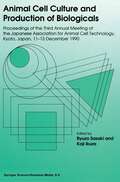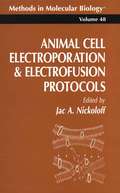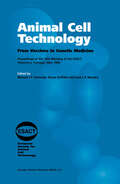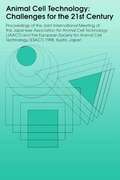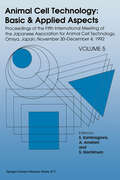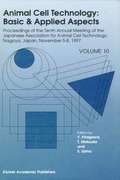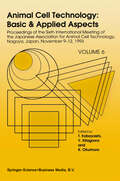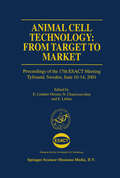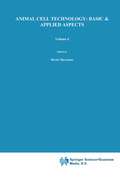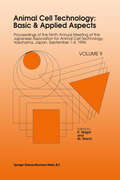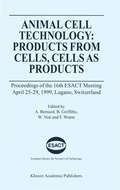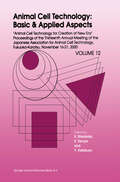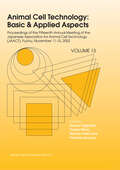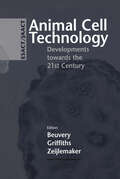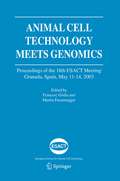- Table View
- List View
Animal Cell Culture: Essential Methods (Essential Methods Ser. #3)
by John DavisThis is a comprehensive research guide that describes both the key new techniques and more established methods. Every chapter discusses the merits and limitations of the various approaches and then provides selected tried-and-tested protocols, as well as a plethora of good practical advice, for immediate use at the bench. It presents the most accessible and comprehensive introduction available to the culture and experimental manipulation of animal cells. Detailed protocols for a wide variety of methods provide the core of each chapter, making new methodology easily accessible. This book is an essential laboratory manual for all undergraduates and graduates about to embark on a cell culture project. It is a book which both experienced researchers and those new to the field will find invaluable.
Animal Cell Culture: Essential Methods (Essential Methods)
by John M. DavisThis is a comprehensive research guide that describes both the key new techniques and more established methods. Every chapter discusses the merits and limitations of the various approaches and then provides selected tried-and-tested protocols, as well as a plethora of good practical advice, for immediate use at the bench. It presents the most accessible and comprehensive introduction available to the culture and experimental manipulation of animal cells. Detailed protocols for a wide variety of methods provide the core of each chapter, making new methodology easily accessible. This book is an essential laboratory manual for all undergraduates and graduates about to embark on a cell culture project. It is a book which both experienced researchers and those new to the field will find invaluable.
Animal Cell Culture (Methods in Molecular Biology #5)
by John M. Walker, Jeffrey W. Pollard and John M. WalkerFor many years I performed tissue culture in large scientific insti- tions that had a great deal of infrastructure. When I set up a tissue l- oratory outside such an infrastructure, however, I found there was a shortage of easily accessible information about the basic needs, reagents, and techniques for establishing such a facility. Much had to be done by trial and error or gleaned from originalpapers. Consequently, I felt that a methods book covering a wide variety of techniques from basic culture to the most sophisticated cell analysis would be a very valuable addition to the scientific literature. In the interim, several useful books (listed in Chapter I of this volume) did appear, but none entirely fitted the bill and some are now somewhat dated. Then, in 1984, the first of the Methods in Molecular Biology volumes from Humana Press was published with its step-by-step recipe approach. This format appealed to me, and so I c- tacted John Walker, the series editor, about including cell culture in this series. The result was that we embarked upon a single volume covering both plant and animal cell culture. Such was the richness of the material that this project soon divided itself into separate volumes on animal cell (Volume 5) and plant cell (Volume 6) culture. In this volume (Volume 5), therefore, we have aimed to describe a variety of basic techniques and culture conditions for a range of cell types.
Animal Cell Culture and Production of Biologicals: Proceedings of the Third Annual Meeting of the Japanese Association for Animal Cell Technology, held in Kyoto, December 11–13, 1990
by Ryuzo Sasaki Kouji IkuraIn the past two decades, the importance of animal cell technology has increased enormously. First, useful proteins can be produced by cultured animal cells, in which the desired product can be modified and organized so as to retain its biological function. Second, studies of cultured cells can provide information needed to understand molecular mechanisms that govern what happens in tissues, organs, and even entire organisms. For this second purpose, biochemists and molecular biologists may need a large number of such cells. Third, cultured cells can be used instead of tissues and organs clinically. The Third Annual Meeting of the Japanese Association for Animal Cell Technology (JAACT), at which participants from abroad were warmly welcomed, was held in Kyoto on December 11-13, 1990. It was organized around the idea of providing a place for the review of much new data on such applications of cultured cells and for exchanges of the views of the participants about progress in the field. This volume, divided into seven sections, contains the proceedings of the meeting. The first section reviews the molecular basis of the control of animal cell growth. In the following sections, physicochemical and biochemical factors for cell growth and production of biologicals, cell culture systems including serum-free culture, new cell lines, specific products and their characteristics, and in vitro assays for toxic, carcinogenic, and pharmacological effects are taken up in their tum.
Animal Cell Culture and Technology (THE BASICS (Garland Science))
by Michael ButlerAnimal cell culture is an important laboratory technique in the biological and medical sciences. It has become an essential tool for the study of most biochemical and physiological processes and the use of large-scale animal cell culture has become increasingly important to the commercial production of specific compounds for the pharmaceutical industry. This book describes the basic requirements for establishing and maintaining cell cultures both in the laboratory and in large-scale operations. Minimal background knowledge of the subject is assumed and therefore it will be a readable introduction to animal cell culture for undergraduates, graduates and experienced researchers. Reflecting the latest developments and trends in the field, the new topics include the latest theory of the biological clock of cell lines, the development of improved serum-free media formulations, the increased understanding of the importance and control of protein glycosylation, and the humanization of antibodies for therapeutic use.
Animal Cell Culture and Technology (THE BASICS (Garland Science))
by Michael ButlerAnimal cell culture is an important laboratory technique in the biological and medical sciences. It has become an essential tool for the study of most biochemical and physiological processes and the use of large-scale animal cell culture has become increasingly important to the commercial production of specific compounds for the pharmaceutical industry. This book describes the basic requirements for establishing and maintaining cell cultures both in the laboratory and in large-scale operations. Minimal background knowledge of the subject is assumed and therefore it will be a readable introduction to animal cell culture for undergraduates, graduates and experienced researchers. Reflecting the latest developments and trends in the field, the new topics include the latest theory of the biological clock of cell lines, the development of improved serum-free media formulations, the increased understanding of the importance and control of protein glycosylation, and the humanization of antibodies for therapeutic use.
Animal Cell Culture: Principles and Practice (Techniques In Life Science And Biomedicine For The Non-expert Ser.)
by Shalini Mani Manisha Singh Anil KumarAnimal Cell Culture: Principles and Practice (Techniques in Life Science and Biomedicine for the Non-Expert)
by Shalini Mani Manisha Singh Anil KumarThis introductory guide provides novice researchers and lab students with a thorough step-by-step approach to standard animal cell culture techniques. Coverage includes lab safety and best practices, sterility management, preparation, ethical considerations, and troubleshooting for common pain points. This is an up-to-date, indispensable handbook for early-career researchers and students, as well as established scientists in biotechnology, cell and developmental biology, pharmaceutical toxicology, cytogenetics, and more.
Animal Cell Culture Techniques (Springer Lab Manuals)
by Martin ClynesCell culture techniques allow a variety of molecular and cell biological questions to be addressed, offering physiological conditions whilst avoiding the use of laboratory animals. In addition to basic techniques, a wide range of specialised practical protocols covering the following areas are included: cell proliferation and death, in-vitro models for cell differentiation, in-vitro models for toxicology and pharmacology, industrial application of animal cell culture, genetic manipulation and analysis of human and animal cells in culture.
Animal Cell Electroporation and Electrofusion Protocols (Methods in Molecular Biology #48)
by Jac A. NickoloffThe ability to introduce macromolecules into animal cells, includ ing DNA, RNA, proteins, and other bioactive compounds has facili tated a broad range of biological studies, from biochemistry and biophysics to molecular biology, cell biology, and whole animal stud ies. Gene transfer technology in particular will continue to play an essential role in studies aimed at improving our understanding of the relationships between the gene structure and function, and it has impor tant practical applications in both biotechnology and biomedicine, as evidenced by the current intense interest in gene therapy. Although DNA and other macromolecules may be introduced into cells by a variety of methods, including chemical treatments and microinjection, el- troporation has proven to be simpler to perform, more efficient, and effective with a wider variety of cell types than other techniques. The early and broad success of electric field-mediated DNA transfer soon prompted researchers to investigate electroporation for transferring other types of molecules into cells, including RNA, enzymes, antibodies, and analytic dyes. Animal Cell Electroporation and Electrofusion Protocols begins with three chapters that describe the theoretical and practical aspects of electroporation, including a review of the commercially available instrumentation. These introductory chapters will be of particular inter est to those new to electric field technologies and to those developing protocols for as yet untested species or cell types. Nineteen chapters follow that present well-tested protocols for electroporation of proteins and DNA into insect, fish, and mammalian cells.
Animal Cell Technology: From Vaccines to Genetic Medicine
by Manuel J. T. Carrondo Bryan Griffiths José L. P. MoreiraAnimal cell technology has undergone a rapid transformation over the last decade from a research tool and highly specialised technology to a central resource for innovation in pharmaceutical research and development. These proceedings of the 14th Meeting of the European Society for Animal Cell Technology (Vilamoura, Portugal, May 1996) bring up to date the historical perspective of animal cell technology for the benefit of society, `From Vaccines to Genetic Medicine', and will charter this vital technology for the years to come. Strong contributions are grouped in the traditional ESACT areas of 'Cell and Physiology Engineering' dealing with cell state, including genetics, and its environment, and 'Animal Cell Process Engineering' covering integration of bioreaction with bioseparation coupled with on-line monitoring to improve protein production and consistency. Extensive coverage of metabolic engineering on synthesis, folding, assembly, transiting and secretion is dealt with in the session on 'Recombinant Proteins: Biosynthesis and Bioprocessing'. Two traditional but expanding areas of animal cell technology relevance are highlighted in the broad sessions of 'Animal Cells as Tools for Discovery and Testing' and 'Animal Cell Vaccines: Present and Future'. Two sessions finally cover the more recent domains of animal cell technology work - 'Tissue Engineering and Biomedical Devices' and 'Cells and Vectors for Genetic Medicine' - where one can foresee a very bright future.
Animal Cell Technology: Proceedings of the Seventeenth Annual Meeting of the Japanese Association for Animal Cell Technology (JAACT), Nagoya, Japan, November 15-18, 2004 (Animal Cell Technology: Basic & Applied Aspects #14)
by Shinji Iijima Ken-Ichi NishijimaComplete updates of rapidly expanding fields of animal cell technology Covers all topics from academic to industrial matters
Animal Cell Technology: Proceedings of the 19th Annual Meeting of the Japanese Association for Animal Cell Technology (JAACT), Kyoto, Japan, September 25-28, 2006 (Animal Cell Technology: Basic & Applied Aspects #15)
by Koji Ikura Masaya Nagao Akira Ichikawa Kiichiro Teruya Sanetaka ShirahataAnimal cell technology is a growing discipline of cell biology which aims not only to understand structures, functions and behaviors of differentiated animal cells, but also to ascertain their abilities to be used for industrial and medical purposes. The goal of animal cell technology includes the clonal expansion of differentiated cells, the optimization of their culture conditions, modulation of their ability to produce proteins of medical and pharmaceutical importantance, and the application of animal cells to gene therapy, artificial organs and the production of functional foods. This volume gives the readers a complete review of the present state-of-the-art and will be useful for those working in either academic environments or in the biotechnology and pharmaceutical sectors, particularly cell biologists, biochemists, molecular biologists, immunologists, biochemical engineers and all other disciplines related to animal cell culture.
Animal Cell Technology: Proceedings of the joint international meeting of the Japanese Association for Animal Cell Technology (JAACT) and the European Society for Animal Cell Technology (ESACT) 1998, Kyoto, Japan
by Kouji Ikura Seiji Masuda Masaya Nagao Ryuzo SasakiAnimal cell technology aims to understand structures, functions, and behaviors of differentiated animal cells and to ascertain their abilities to be used in industrial and medical purposes. This volume gives readers a complete review of the present state of the art in Japan.
Animal Cell Technology: Proceedings of the Fifth International Meeting of the Japanese Association for Animal Cell Technology, Omiya, Japan, November 30–December 4, 1992 (Animal Cell Technology: Basic & Applied Aspects #5)
by S. Kaminogawa A. Ametani S. HachimuraAnimal cell technology has been making tremendous progress. Originally this term reminded people of engineering for high density and large volume culture of animal cells. At present many fields of biological sciences are aiming at advance in animal cell technology. Cell culture engineering is aided not only with developments in apparatus, matrix, media, and computational analysis, but also with new biological procedures in gene and protein technology, cell biological resources and immunological methods. Results obtained with animal cell technology are applied to production of pharmaceuticals, diagnosis reagents and food endowed with physiological functions, and cell and gene therapy of animals and humans, and useful for elucidating scientific phenomena. It is also essential to establish methods of evaluation for functionality and safety of newly discovered molecules and cells. The progress in animal cell technology is supported by, and attributes in both of basic and applied sciences. The proceedings of the Fifth International Meeting of the Japanese Association for Animal Cell Technology (JAACT) covers the subjects above mentioned. The articles in this book will help researchers in many fields to understand the current status and future trends in animal cell technology. JAACT organized this Meeting and we express our gratitude to the members of JAACT. We gratefully acknowledge all the members of the organizing committee for their dedication in assuring the Meeting's success. For their valuable supports, we also thank the Japanese Biolndustry Association and Saitama Foundation for Culture and Industry.
Animal Cell Technology: Proceedings of the Tenth Annual Meeting of the Japanese Association for Animal Cell Technology, Nagoya, November 5–8, 1997 (Animal Cell Technology: Basic & Applied Aspects #1)
by Y. Kitagawa T. Matsuda S. IijimaAnimal cell technology is a growing discipline of cell biology which aims not only to understand structures, functions and behaviors of differentiated animal cells but also to ascertain their abilities to be used for industrial and medical purposes. The goal of animal cell technology includes accomplishments of clonal expansion of differentiated cells with useful ability, optimization of their culture conditions, modulation of their ability for production of medically and pharmaceutically important proteins, and the application of animal cells to gene therapy and artificial organs. This Volume gives the readers a complete review of the present state of the art in Japan. The Proceedings will be useful for cell biologists, biochemists, molecular biologists, immunologists, biochemical engineers and other disciplines related to animal cell culture, working either in academic environments or in industries of biotechnology and pharmacy.
Animal Cell Technology: Proceedings of the Sixth International Meeting of the Japanese Association for Animal Cell Technology, Nagoya, Japan, November 9–12, 1993 (Animal Cell Technology: Basic & Applied Aspects #6)
by T. Kobayashi Y. Kitagawa K. OkumuraAnimal cell technology is a growing discipline of cell biology which aims to understand the structure, function and behaviour of differentiated animal cells, and especially the development of such abilities as are useful for industrial purposes. These developments range from clonal expansion of differentiated cells with useful abilities, to optimization of cell culture on industrial scale and modulation of the cells' abilities to produce drugs and monoclonal antibodies. The sixth volume in this series gives a complete review of today's state of the art in Japan, a country where this field is especially well advanced. It will be of interest to cell biologists, biochemists, molecular biologists, immunologists and other disciplines related to animal cell culture, working in the academic environment as well as in (biotechnology or pharmaceutical) industry.
Animal Cell Technology: Proceedings of the 17th ESACT Meeting Tylösand, Sweden, June 10–14, 2001 (ESACT Proceedings #1)
by E. Lindner-Olsson N. Chatzissavidou E. LüllauProceedings of the 17th ESACT Meeting June 10-14, 2001, Tylösand, Sweden
Animal Cell Technology: Proceedings of the Fourth Annual Meeting of the Japanese Association for Animal Cell Technology, Fukuoka, Japan, 13–15 November 1991 (Animal Cell Technology: Basic & Applied Aspects #4)
by H. Murakami Sanetaka Shirahata H TachibanaNew data on animal cell technology are brought together in this volume, with emphasis given to the basic characterization of cell lines. The merits of different cell culture systems are examined and investigations into the factors influencing cell growth and productivity are presented. A special section deals with the biological properties of proteins produced by engineered animal cells. All those involved in the culture of animal cells will find this volume invaluable.
Animal Cell Technology: Proceedings of the Ninth Annual Meeting of the Japanese Association for Animal Cell Technology, Yokohama, Japan, September 1–4, 1996 (Animal Cell Technology: Basic & Applied Aspects #9)
by K. Nagai M. WachiAnimal cell technology is a growing discipline of cell biology which aims not only to understand structures, functions and behaviors of differentiated animal cells but also to uncover their abilities for industrial and medical purposes. The goal of animal cell technology includes clonal expansion of differentiated cells with useful abilities, optimization of their culture conditions on the industrial scale, modulation of their ability in order efficiently to produce medically and pharmaceutically important proteins, and application of animal cells to gene therapy and formation of artificial organs. This Volume gives the readers a complete review of the present state of the art in Japan, a country where this field is well advanced, as well as in Asia, Europe and the United States. The Proceedings will be useful for cell biologists, biochemists, molecular biologists, biochemical engineers and those in other disciplines related to animal cell culture, working in academic environments as well as in the biotechnology and pharmaceutical industries.
Animal Cell Technology: Proceedings of the 16th ESACT Meeting April 25–29, 1999, Lugano, Switzerland
by Wolfgang Noé Florian Wurm Alain Bernard Bryan GriffithsProceedings of the 16th ESACT Meeting, April 25-29, 1999, Lugano, Switzerland
Animal Cell Technology: Proceedings of the Thirteenth Annual Meeting of the Japanese Association for Animal Cell Technology (JAACT), Fukuoka-Karatsu, November 16–21, 2000 (Animal Cell Technology: Basic & Applied Aspects #12)
by Sanetaka Shirahata Kiichiro Teruya Yoshinori KatakuraAnimal cell technology is a growing discipline of cell biology, which aims not only to understand structures, functions, and behaviours of differentiated animal cells but also to ascertain their ability to be used for industrial and medical purposes. The goal of animal cell technology includes accomplishments of clonal expansion of differentiated cells with useful ability, optimisation of their culture conditions, modulation of their ability for production of medically and pharmaceutically important proteins, and the application of animal cells to gene therapy, artificial organs, and functional foods. This volume gives the reader a complete review of the present state of the art in Japan and other countries where this field is well advanced. The Proceedings will be useful for cell biologists, biochemists, molecular biologists, immunologists, biochemical engineers, and other disciplines related to animal cell culture, working in either academic environments or in industries of biotechnology and pharmacy.
Animal Cell Technology: Proceedings of the Fifteenth Annual Meeting of the Japanese Association for Animal Cell Technology (JAACT), Fuchu, Japan, November 11-15, 2002 (Animal Cell Technology: Basic & Applied Aspects #13)
by Kazumi Yagasaki Yutaka Miura Makoto Hatori Yoshihiro NomuraAnimal cell technology is a growing discipline of cell biology which aims not only to understand structures, functions and behaviors of differentiated animal cells, but also to ascertain their abilities to be used in industrial and medical purposes. The goal of animal cell technology includes accomplishments of clonal expansion of differentiated cells with useful ability, optimization of their culture conditions, modulation of their ability for production of medically and pharmaceutically important proteins and the application of animal cells to gene therapy, artificial organs and functional foods. This volume gives the readers a complete review of present state-of-the-art in Japan and other countries where this field is well advanced. The Proceedings will be useful for the cell biologists, biochemists, molecular biologists, immunologists, biochemical engineers and other disciplines related to animal cell culture, working in either academic environments or in industries of biotechnology and pharmacy.
Animal Cell Technology: Developments towards the 21st Century
by E. C. Beuvery W. P. Zeijlemaker J. B. GriffithsAnimal cell technology is a discipline of growing importance, which aims not merely at understanding structure, function and behaviour of differentiated animal cells, but especially at the development of their abilities useful for clinical application. Topics of interest in this regard include: viral vaccines, pharmaceutical proteins and novel applications such as gene therapy and organ culture. Undoubtedly, these Proceedings of the joint Meeting of the European Society for Animal Cell Technology and the Japanese Association for Animal Cell Technology (Veldhoven, The Netherlands, September 1994) review the most recent status of the field, and will be most valuable to anyone actively involved in the culture of animal cells and its applications. The contributions to this volume were strictly selected on the basis of quality and novelty of contents. Kluwer is honoured to be able to add this work to its strongly developing publication programme in cell and tissue culture, which now has its connections to all major Societies in this field worldwide. Audience: Cell biologists, biochemists, molecular biologists, immunologists, virologists and all other disciplines related to animal cell technology, working in an academic environment, as well as in (biotechnology or pharmaceutical) industry.
Animal Cell Technology Meets Genomics: Proceedings of the 18th ESACT Meeting. Granada, Spain, May 11-14, 2003 (ESACT Proceedings #2)
by Francesc Gòdia Martin M. FusseneggerThe 18th ESACT meeting was celebrated in Granada (Spain) in May 2003, and was entitled "Animal Cell Technology Meets Genomics", in order to reflect that the emerging technologies in the area of genomics, proteomics and other "-omics"-type disciplines will provide key technological assets to increase knowledge and open new horizons in animal cell technology. During the meeting a variety of top-class emerging technologies were presented together with the lastest advances in more mature industrial areas. The meeting was opened by a first session devoted to the understanding of basic cellular mechanisms, and four sessions focused on applied aspects of animal cell technology: Cell-based therapies and gene-based therapies, target discovery and biopharmaceuticals. The Granada Meeting has also seen a special focus on forefront industrial case studies. The spirit and scientific excellence of the 18th ESACT meeting is now reflected in different chapters of the book. The book presents, in form of short papers, a high number of the contributions to the meeting, and has been prepared with the aim to provide a relevant reference of the current research efforts in Animal Cell Technology.


